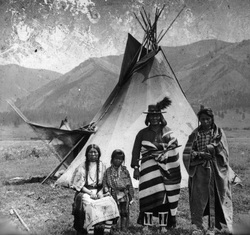 Recent Logo of Confederation
Recent Logo of Confederation The Salish are also commonly referred to as Flatheads, a name given to them by Europeans, and used to differentiate them from other tribes that didn’t practice ‘shaping’ a baby’s head. While they began expanding early, their progress was checked by other tribes, primarily the Blackfeet. They fled to the mountains, and have been there ever since.
Early Roots
 Flathead Lake
Flathead Lake The Salish are spread out about the Northwest and into British Columbia, and they even began spreading out onto the Great Plains. Still, their expansion didn’t last long; by 1600 other tribes like the Blackfeet, themselves pushed west by Europeans, began to push the Salish back to their original territory. Realizing that they were no match for the Blackfeet, the Salish pulled back and expanded further west instead. Those that decided to settle in Montana did so around the Three Forks area, and even travelled regularly as far as the Big Horn Mountains.
Bitter Enemies
 Salish family, c. 1900
Salish family, c. 1900  Blodgett Canyon in Bitterroot Valley
Blodgett Canyon in Bitterroot Valley Whether they were here during the last ice age or not, the rest of the world didn’t come to learn of the Salish until the Lewis and Clark expedition, at which point they were a tribe living in fear and willing to ally themselves with anyone that would protect them from Blackfeet, including whites who had originally taken the Blackfeet’s land, and would do so again.
Notes
Pritzer, Barry. Native Americans [2 Volumes]: An Encyclopedia of History, Culture, and Peoples. ABC-CLIO: Santa Barbara, 1998. p 272-3
Malone, Michael Peter; Roeder, Richard B.; Lang, William L. Montana: A History of Two Centuries. The University of Washington Press, 1976. p 14-15.
Salish-Pend d’Oreille Culture Committee and Elders Cultural Advisory Council. The Salish People and the Lewis and Clark Expedition. Confederated Salish and Kootenai Tribes: Canada, 2005. p 7-9.

